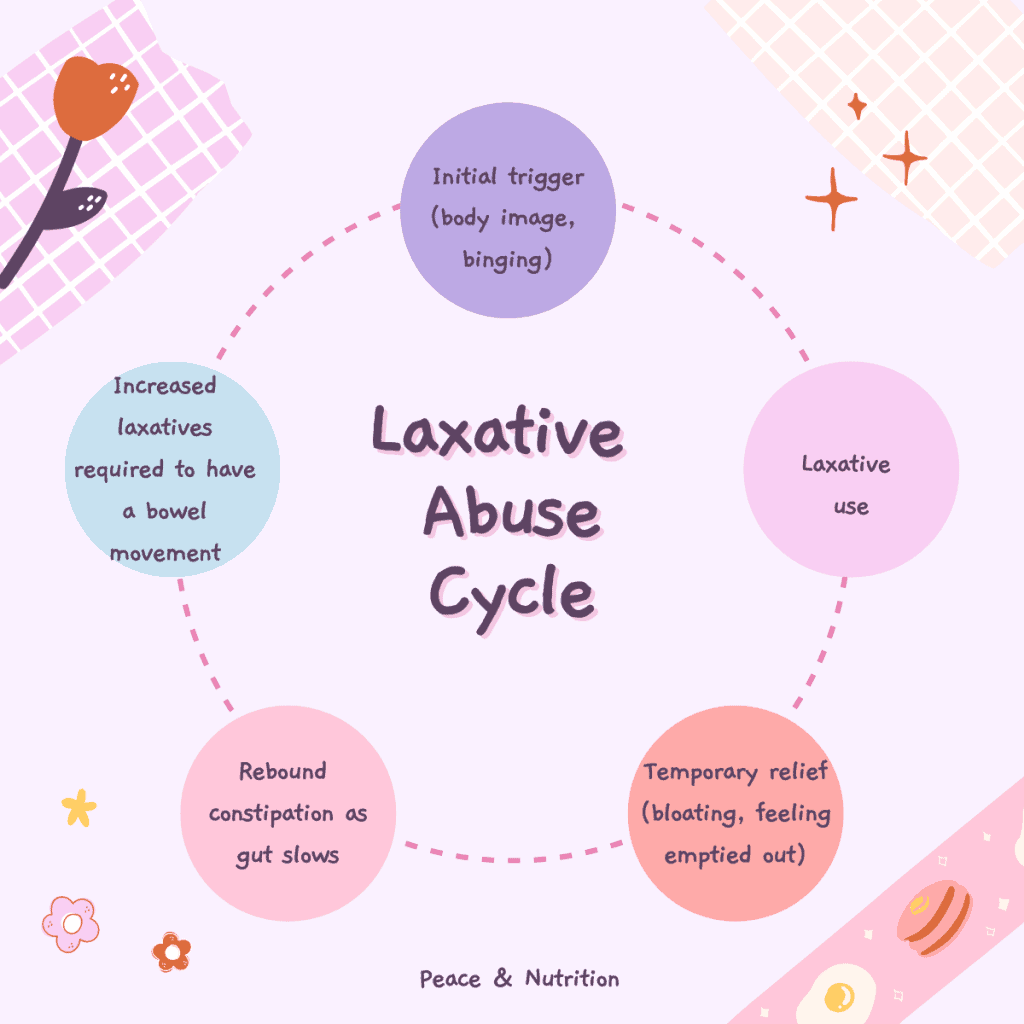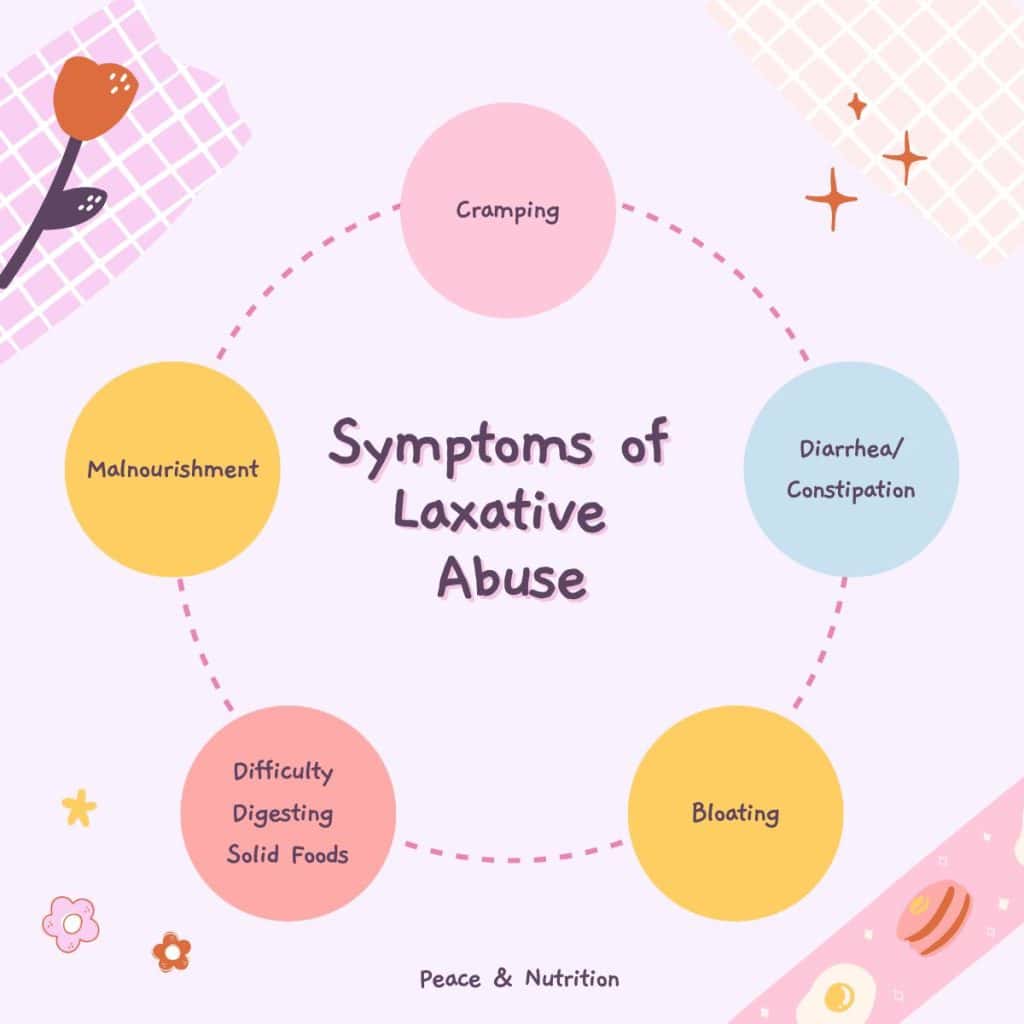Table of Contents
Last updated on September 15th, 2025 at 08:57 pm
Recovering from laxative abuse can feel overwhelming, especially if you’ve been relying on them for weight control, relief from bloating, or to manage constipation. Over time, laxative misuse can damage the digestive system, create painful dependency, and lead to dangerous electrolyte imbalances. The good news is that with the right support, your body can heal.
Laxative abuse recovery focuses on gently retraining the bowels, restoring hydration and nutrient balance, and addressing the emotional and behavioral patterns that fuel the cycle. Whether your goal is to break free from laxative dependence or heal from an eating disorder, understanding the recovery process is the first step toward long-term digestive health and freedom from laxatives.
This article explores the common triggers for laxative use to laxative abuse and what to do if you feel like you have a problem with laxatives.
What is Laxative Abuse
Laxative abuse is the repeated, inappropriate, or excessive use of laxatives to control weight, change body shape, relieve perceived “fullness,” or trigger bowel movements when it’s not medically necessary, often in ways that harm the body.Abusing laxatives is a common form of purging in eating disorders.
Laxative abuse includes:
- Taking laxatives when not medically necessary
- A dependency on laxatives to have regular bowel movements
- Feeling a compulsion to use laxatives
- Extreme guilt or shame when laxatives are not used
- Socially isolating to hide laxative abuse
The Cycle of Laxative Abuse
The cycle of laxative abuse is a repeating pattern that keeps people stuck, physically, emotionally, and sometimes psychologically dependent on the behavior. It’s driven by both body changes from laxatives and the mental reinforcement that comes with them. It often involves 5 repeating stages that can feel impossible to break free from.
- Initial trigger (constipation, body image concerns, dieting, binge episode)
- Laxative use
- Temporary relief (bloating reduction, feeling “emptied out”)
- Rebound constipation as gut slows further
- Increased laxative use required to get results again

Excessive Laxative Use and Eating Disorders
Laxative abuse It is often referred to as an atypical eating disorder and it falls under the category of OSFED when laxative abuse becomes severe. A person with an eating disorder may desire to lose weight or “get rid of” certain food from the body. While no calories are lost with excessive laxative use, it is often used by a person with an eating disorder to help them feel “empty” inside.
Types of laxatives include stimulant agents, osmotic and saline products, bulking agents and surfactants. The most commonly abused laxative for persons with eating disorders are stimulants.
Laxatives force the muscles to contract and propel food from the body. People that abuse laxatives may become obsessed with the appearance of the stomach or having a “flat stomach”
Excessively using laxatives is often a result of:
- following a clean eating plan (and not wanting “bad” foods in your body)
- Desire to lose weight
- Trying to eliminate fear foods from the body
- Desire to have a flat tummy
- Fear of feeling full or bloated
Symptoms of Laxative Abuse
Many people that abuse laxatives begin to focus their day on the availability of restrooms as they are often having to use the bathroom frequently. People that abuse laxatives may also socially isolate as they may frequently have gas, stomach pain, or other adverse effects of their habit.
Symptoms of laxative abuse can range from moderate to life threatening. It is very common for a person abusing laxatives to have periodic bouts of diarrhea and constipation. Purging through laxatives can also lead to cardiac arrest.
Some common symptoms of laxative abuse include:
- Dehydration
- Electrolyte imbalance
- Loss of colon function
- Nutrient deficiencies
- Bloating
- Nausea
- Cramps
- Hair loss
- Lanugo or hair on the body
- Gastroperisis

Steps To Stop Laxative Abuse
It is important to gradually decrease laxative abuse rather than stopping abruptly.
To reduce and stop laxative abuse:
- Set up regular visits with an eating disorder treatment team
- Stop stimulant laxatives and replace with fibre/osmotic supplements
- Reduce the frequency of use (if taking daily try to reduce to every other day)
- Reduce the dose slightly each week
- Increase fiber gradually (whole grains, fruits, vegetables, beans, lentils)
- Stay hydrated
- Get in some gentle movement to help move the bowels
- Practice a structured bathroom routine (sitting on the toilet the same time daily, using a squatty potty if you become constipated to help with position)
- Monitor your electrolytes with a healthcare provider, especially if you have been using laxatives for a long time
- Cover mirrors and remove scales if possible to prevent body checking

Retraining Bowels Excessive Laxative Use
Retraining the bowels after laxative abuse is a slow, careful process because prolonged laxative use can disrupt the normal function of the colon, weaken the muscles and nerve signaling, and cause dependency for bowel movements. Recovery involves both medical guidance and supportive lifestyle changes.
If you have been excessively using laxatives, the muscles in your digestive tract are no longer functioning as they should.
Retraining your bowels after excessive laxative use will involve:
- Consistently eating throughout the day
- Strengthening your mussels to be able to tolerate solid foods
- Sustaining good bathroom habits
- Learning to sit with the sensation of fullness
Symptoms of Laxative Abuse Recovery
People who abuse laxatives physically and emotionally lose touch with normal bowel function. They may feel as though they are constipated if they aren’t having diarrhea multiple times per day as that is what their body is now accustomed to.
Common symptoms include:
- Bloating
- Constipation
- Stomach pain
- Diarrhea
Minimizing Discomfort in Recovery
While some discomfort should be expected, there are tools, supplements and medications that may help to ease some of the discomfort. While some discomfort is normal, seek medical attention right away if you have no bowel movement for >7 days despite interventions, vomiting with constipation, blood in the stool or severe abdominal pain.
Some things that might help ease discomfort as you stop using laxatives include:
- Heat packs on the tummy
- Mild, non stimulant laxative such as magnesium citrate, docusate, or psyllium husk.
- Probiotics (fermented foods, yogurt)
- Peppermint, ginger, or chamomile tea may help ease bloating and cramping
- Abdominal message
- A small amount of flaxseed mixed with water can act as a bulking agent
- Using liquid calories for a portion of total calories
- Diet Culture is Toxic - December 22, 2025
- I Don’t Eat Anything White - December 11, 2025
- I Wish I Had More Control With Food - November 18, 2025